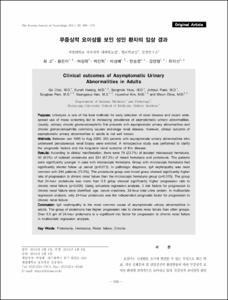무증상적 요이상을 보인 성인 환자의 임상 경과
- Keimyung Author(s)
- Hwang, Eun Ah; Park, Sung Bae; Han, Seung Yeup; Kim, Hyun Chul; Choe, Mi Sun
- Journal Title
- Korean Journal of Nephrology
- Issued Date
- 2011
- Volume
- 30
- Issue
- 4
- Keyword
- Proteinuria; Hematuria; Renal failure; Chronic
- Abstract
- Purpose: Urinalysis is one of the best methods for early detection of renal disease and recent wide- spread use of mass screening led to increasing prevalence of asymptomatic urinary abnormalities. Usually, primary chronic glomerulonephritis first presents with asymptomatic urinary abnormalities and chronic glomerulonephritis commonly causes end-stage renal disease. However, clinical outcome of asymptomatic urinary abnormalities in adults is not well known. Methods: Between Jan 1995 to Aug 2009, 333 patients with asymptomatic urinary abnormalities who underwent percutaneous renal biopsy were enrolled. A retrospective study was performed to clarify the prognostic factors and the long-term renal outcome of this disease. Results: According to clinical manifestation, there were 79 (23.7%) of isolated microscopic hematuria, 30 (9.0%) of isolated proteinuria and 224 (67.3%) of mixed hematuria and proteinuria. The patients were significantly younger in case with microscopic hematuria. Group with microscopic hematuria had significantly shorter follow up period (p=0.013). In pathologic diagnosis, IgA nephropathy was most common with 244 patients (73.3%). The proteinuria group and mixed group showed significantly higher rate of progression to chronic renal failure than the microscopic hematuria group (p=0.015). The group that 24-hour proteinuria was more than 0.5 g/day showed significantly higher progression rate to chronic renal failure (p<0.000). Using univariate regression analysis, 3 risk factors for progression to chronic renal failure were identified: age, serum creatinine, 24-hour total urine protein. In multivariate regression analysis, only 24-hour proteinuria was the independent prognostic factor for progression to chronic renal failure. Conclusion: IgA nephropathy is the most common cause of asymptomatic urinary abnormalities in adults. The group of proteinuria has higher progression rate to chronic renal failure than other groups. Over 0.5 gm of 24-hour proteinuria is a significant risk factor for progression to chronic renal failure in multivariate regression analysis.
- Alternative Title
- Clinical outcomes of Asymptomatic Urinary Abnormalities in Adults
- Publisher
- School of Medicine
- Citation
- 최고 et al. (2011). 무증상적 요이상을 보인 성인 환자의 임상 경과. Korean Journal of Nephrology, 30(4), 368–376.
- Type
- Article
- ISSN
- 1225-0015
- 파일 목록
-
-
Download
 oak-aaa-3260.pdf
기타 데이터 / 483.73 kB / Adobe PDF
oak-aaa-3260.pdf
기타 데이터 / 483.73 kB / Adobe PDF
-
Items in Repository are protected by copyright, with all rights reserved, unless otherwise indicated.